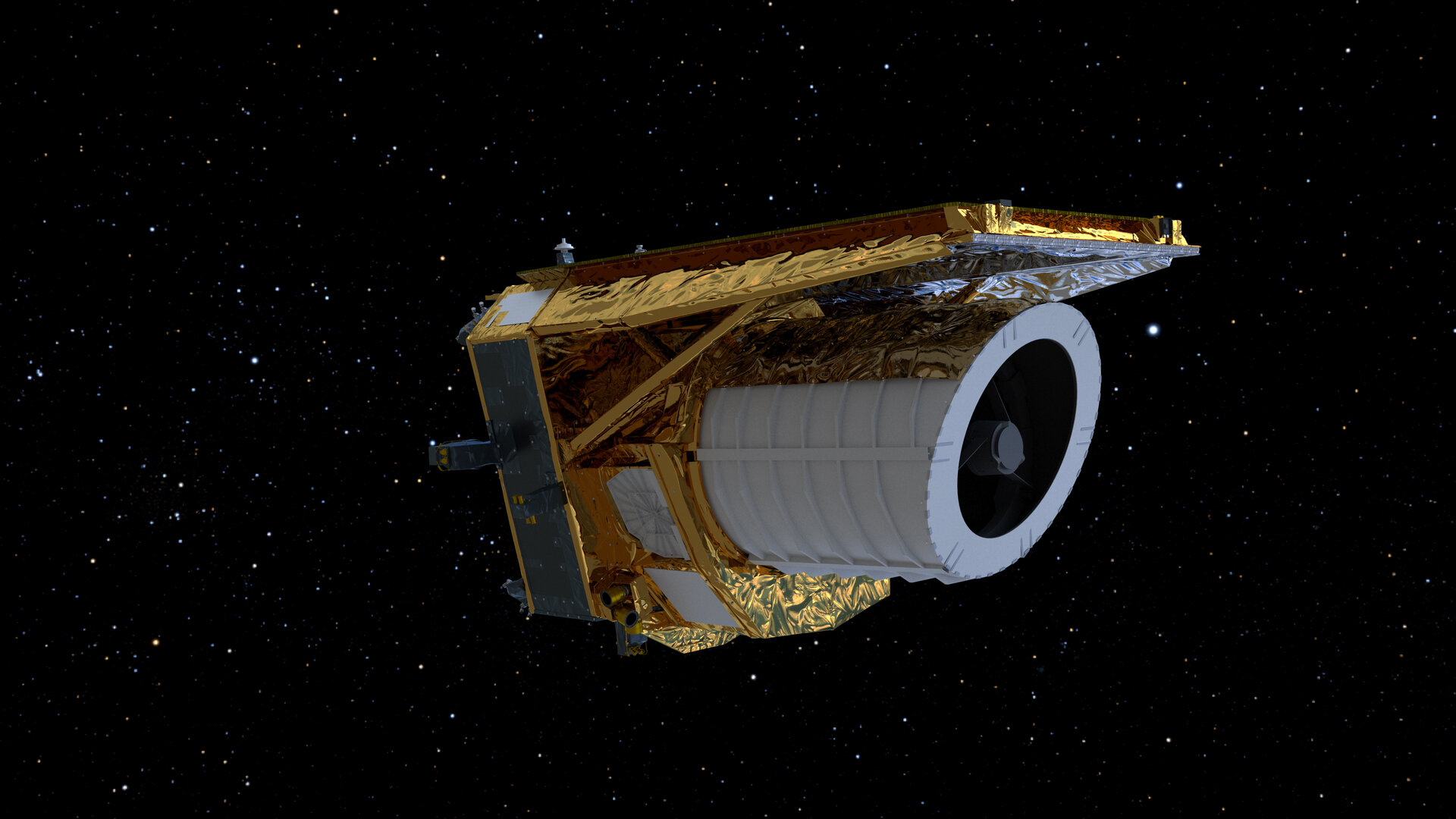Follow Euclid's first months in space
Follow Euclid on its journey to Lagrange point L2 and find out how mission controllers at ESOC in Darmstadt are proceeding with turning on, checking and calibrating the spacecraft’s equipment, the telescope and scientific instruments, as they prepare for routine science observations.
14 February. Euclid starts its science survey
The start of Euclid's survey of the dark Universe. Over the next six years, Euclid will observe billions of galaxies across 10 billion years of cosmic history. And with this milestone achieved, we end this blog covering Euclid's first months in space. For further news on the mission follow the Euclid webpage.
7 November. Release of first images
Euclid revealed its first full-colour images of the cosmos. Five images illustrate Euclid's full potential. They show that the telescope is ready to create the most extensive 3D map of the Universe yet to uncover some of its hidden secrets.
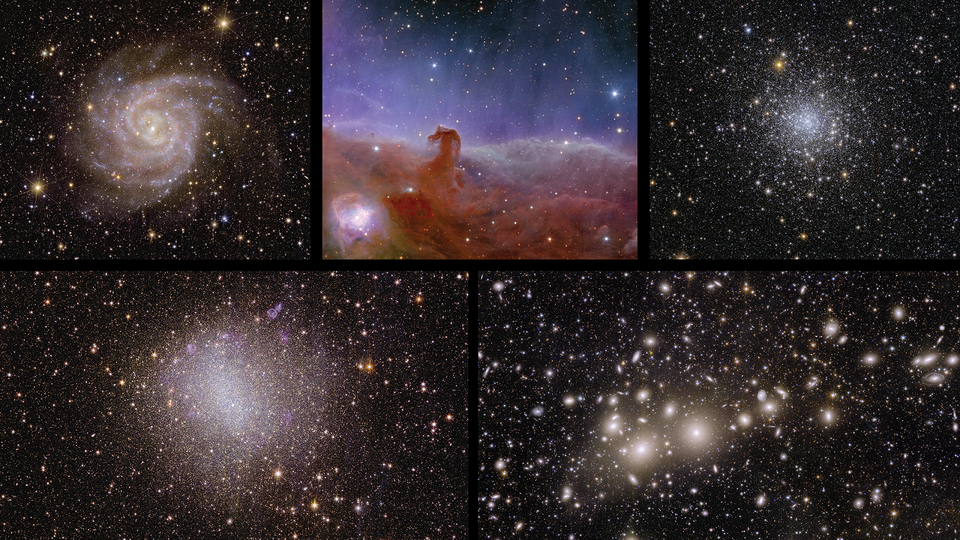
5 October. End of commissioning
Euclid has found its ‘lost’ guide stars as a software patch has solved its navigation woes and the next six years of observation schedules have been redesigned to avoid stray sunlight: it’s the end of an interesting commissioning phase and Euclid will now undergo its final testing in full ‘science mode’.
26 September. Seeking Euclid's hidden stars: commissioning looks up
What challenges did Euclid encounter during commissioning, and how are experts solving the issues?
From the fine guidance sensors intermittently losing track of stars to stray sunlight getting in the way of observing the Universe and X-rays appearing in instrument images, the issues raised do not threaten Euclid's mission but could impact how it carries out its work.
After months of late nights and determination from engineering teams at ESA's mission control, mission scientists and industry, with some tweaking to observation schedules, data processing and by altering the directions Euclid will point in, its looking good for Euclid.
18 September. On-ground tests of updated guiding software completed
Using test benches and simulators, the Euclid operations team has successfully completed on-ground tests of the new software version for fine guiding of the telescope. The updated software is currently being installed on Euclid.
In the coming days, industry and operations experts together with the ESA Science Operation Centre and the Euclid Consortium will carry out an extensive, ten-day long campaign of in-orbit tests to confirm the reliability of the telescope pointing.
When the results of these tests are satisfactory, the performance verification activities will be fully resumed.
5 September. Software update for telescope guiding
The effort to resolve the issues affecting the guiding of the Euclid telescope continues steadfastly (see blog updates 14 and 25 August).
Industry experts are working on an update for the flight software of the Fine Guidance Sensor (FGS), which will be thoroughly tested on-ground before it is installed on the spacecraft. Once the new software is uploaded, the operation team will carry out a week-long series of tests to confirm the update has the desired effect and the telescope can be reliably pointed to cosmic sources again to create sharp images. After this, the performance verification phase will be resumed.
Meanwhile, the Euclid team will progress with performance verification activities that are not sensitive to the reliability of the spacecraft pointing.
25 August. Troubleshooting the fine guidance sensor
Since last week, the Euclid operations team has been working intensively to address the issue affecting the reliability of the fine guidance system which was uncovered during commissioning.
To deliver images of the highest quality Euclid must have a very precise and stable way of pointing the telescope in a given direction. For this, the spacecraft is equipped with the Fine Guidance Sensor (FGS), which consists of optical sensors imaging the sky on the sides of the field of view of the visible instrument (VIS). The FGS uses guide stars to deliver the direction in which the telescope must point with great accuracy. This information is then used by the spacecraft system that controls the orientation and orbital motion, the so-called Attitude and Orbit Control System (AOCS), to point Euclid and to accurately maintain the pointing of the telescope.
During commissioning, the team performed various dedicated tests of the FGS and AOCS. Last week, Euclid was operated in science-like conditions by executing the first activities of the performance verification (PV) phase. Although most systems are performing well, these brought to light cases in which the guidance system failed to deliver and maintain correct pointing. The problem is intermittent, but with a frequency that requires attention. The team found that under certain circumstances the FGS did not provide reliable guiding information, which was problematic for the software on the spacecraft to handle.
To address this situation in the most effective way, the decision has been taken to halt the PV phase and to return to operating the spacecraft in commissioning mode. In the coming days, the team will be developing and testing new software updates, and the schedule for the PV phase will be adjusted.
Giuseppe Racca, Euclid Project Manager, explains: “ESA and industry experts have now developed a temporary solution to identify problematic FGS messages and allow the AOCS to control the orientation correctly. Another team is working in parallel to permanently solve the reliability of the FGS. It was a responsible decision to hold PV and address the problem properly. We are going to test the first solution soon in orbit and all indications are positive. I am confident that we can soon resume PV operations."
14 August. Euclid check-out complete, science 'test-drive' ahead
Euclid is reaching the end of an intense period of commissioning. During the last few weeks, the ESA team, the Euclid Consortium and industry partners have worked tirelessly to check all functions of the spacecraft and instrumentation. The teams confirmed that Euclid's spacecraft and systems, the telescope and scientific instruments work in space as expected or exceeding expectations.
To prevent stray sunlight creeping onto the VIS detectors, Euclid will operate at a range of specific angles with respect to the Sun. In view of this, the planning experts are busy optimizing the survey strategy. Additionally, commissioning of the fine guidance sensor (FGS) is not fully complete. The consistency with which the sensor delivers a reliable pointing direction for the telescope is not yet at the required level and the team is testing different approaches to resolve the issue.
With the wrapping up of commissioning, Euclid is officially starting its next phase: performance verification. During this new phase Euclid’s data-harvesting capabilities will be put to the test.
The operations team will operate the spacecraft in the same way as required for the scientific observations, mimicking the re-pointing strategies to be carried out during the 6-year survey and staring for longer periods in the same direction of the sky. The scientific teams will use these preliminary observations to assess in detail the performance of the instruments and obtain calibration data.
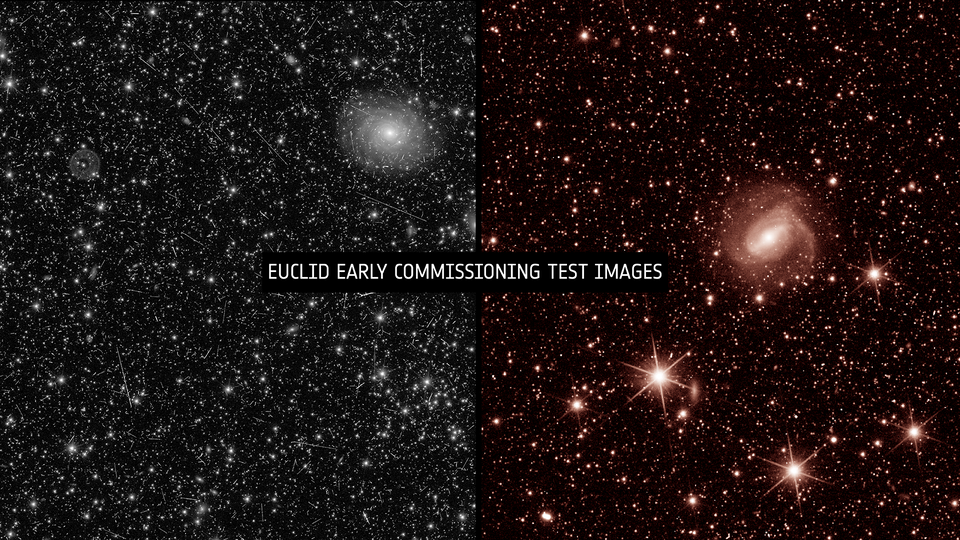
31 July. Euclid test images released
Euclid’s two instruments have captured their first test images. The mesmerising results indicate that the space telescope will achieve the scientific goals that it has been designed for – and possibly much more.
19–28 July. Euclid focused and at destination orbit
In the month after its launch on 1 July, Euclid has travelled 1.5 million kilometres from Earth towards the Sun-Earth Lagrange point L2, meaning it has ‘arrived’ at its destination orbit.
Euclid is also in focus. Over the past week, the position of the secondary mirror, located near the telescope’s entrance, has been adjusted by the telescope manufacturer Airbus Defence and Space France.
Euclid's fine guidance sensor (FGS), which will provide input on where Euclid is pointing, is being calibrated. The FGS will use stars to point the telescope extremely stable to a target in space, ensuring razor sharp images for its survey.
The unnatural light pattern that the VIS sensors picked up (see previous update) is still under investigation. An in-depth investigation is taking place to get a full overview of the effect of this pattern on VIS images. Euclid will be pointed systematically in different angles with respect to the Sun. At each orientation VIS and NISP, as well as the FGS, will take sensitive images to discover which angles are suitable for observing the Universe.

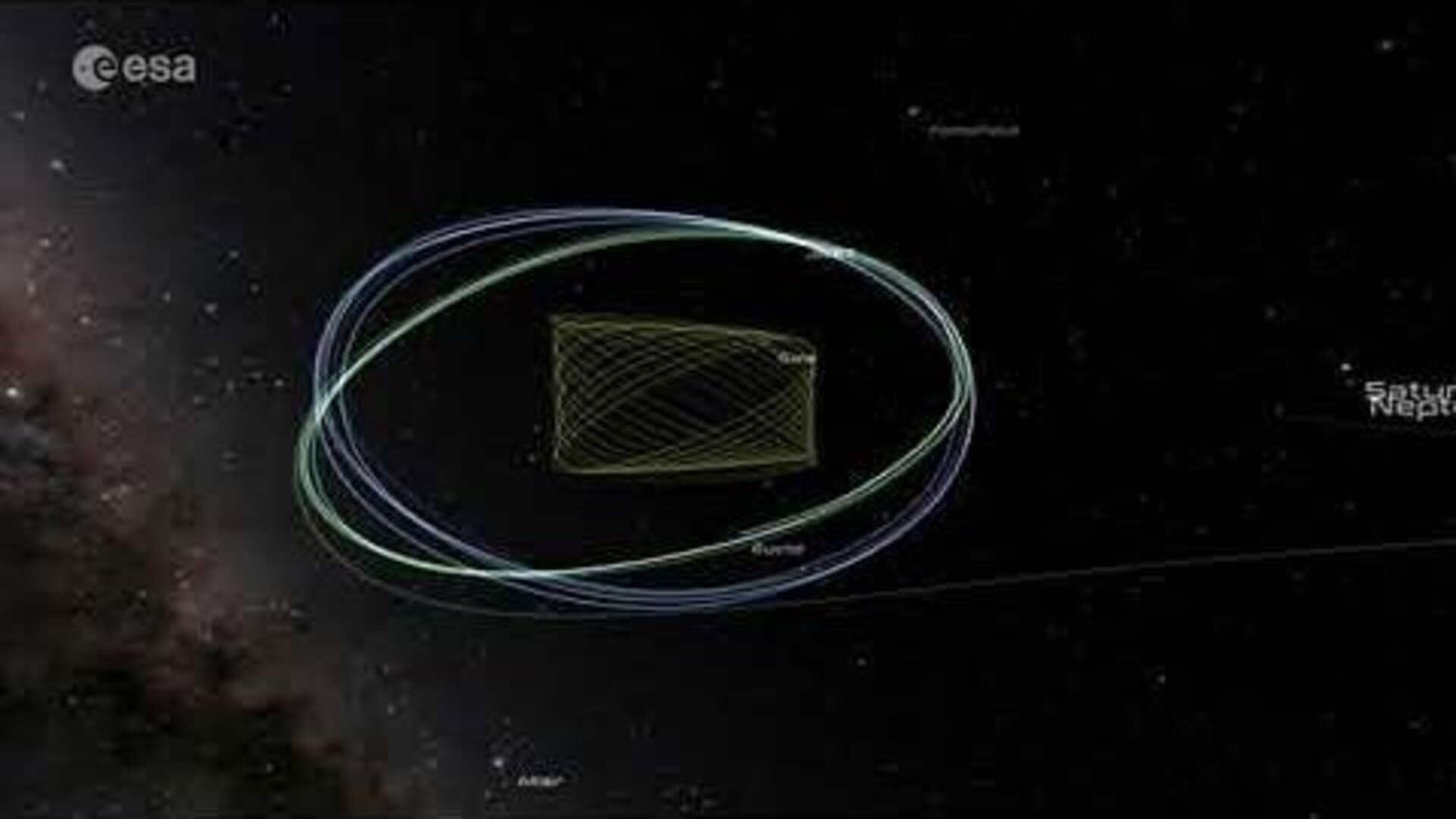
Access the video
15–18 July. VIS and NISP see first light
The commissioning of Euclid is progressing. Mission controllers turned on the VIS and NISP detectors to start recording the light collected by the telescope. The analysis of the detector data confirmed that the sensors of both NISP and VIS are performing well.
At this stage, the telescope is still unfocused. In the coming days the operations team will focus the telescope by carefully adjusting the position of the secondary mirror.
With unfocused optics, the images of stars are still blurry: this is expected. The operations team, however, discovered that the VIS sensors picked up more light than expected. This light caused an unnatural pattern in the VIS image in addition to the true astronomical sources.
The operations team, along with partners in science and industry, are busy investigating further. Last night, they pointed the space telescope in various directions. The tests show that the unexpected light is only detected at specific orientations. This gives us clues about the origin of the extra light and how it could be reduced, and is a promising path forward towards a solution.
12 July. Euclid spotted from the ground
The Canada-France-Hawaii Telescope captured images of Euclid travelling at a distance of about 920 000 km from Earth on the way to its orbit around L2. The trail of the spacecraft moving in front of the background stars can be seen in this sequence of 26 exposures (of three minutes each), in the field of view of the 3.6-m telescope on top of Mauna Kea (Hawaii).
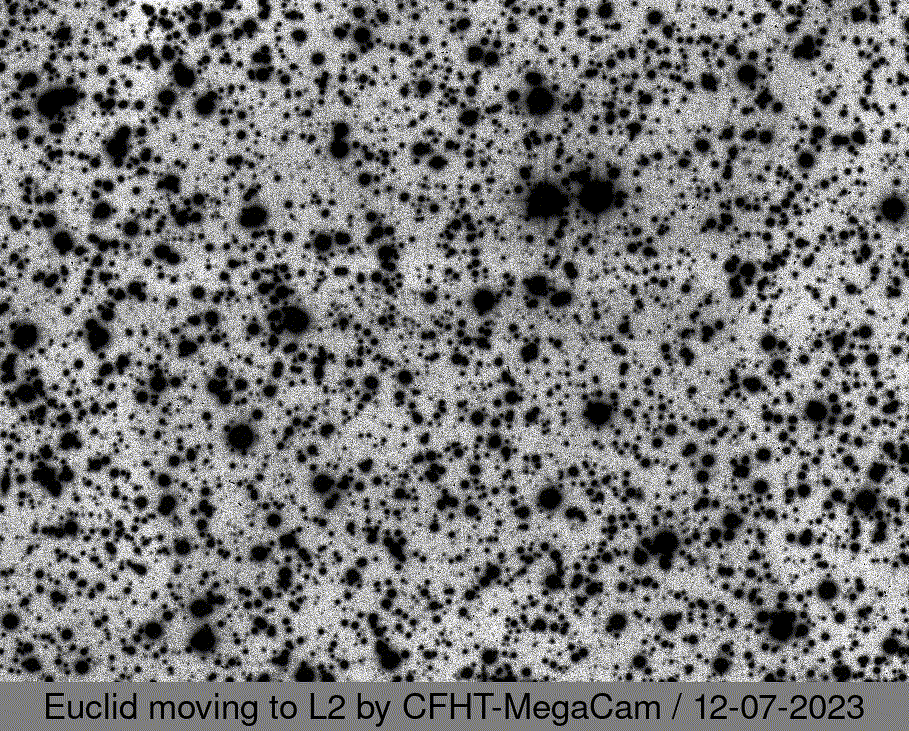
11-12 July. Wake up VIS
VIS control electronics were switched on (primary and redundant branches) and the operations team received ‘synthetic’ data from the instrument confirming its correct functioning.
Additionally, the spacecraft’s micro-propulsion system was activated for the first time and successfully tested. This system is made up of six redundant cold gas micro-propulsion thrusters which are fundamental to making sure Euclid can achieve very precise and stable pointing, and deliver images of the highest quality.
9 July. Release of high-gain antenna
The Euclid operation team sent the command to release the K-band high-gain antenna, part of the spacecraft’s deep-space communications system. This antenna will be used to send more than 100 GB of compressed data down from the spacecraft to a large antenna in ESA’s deep-space communication network Estrack, daily.
Euclid is now the biggest transmitter of data (in terms of data rate of about 74 Mbps) from trans-lunar space. This is around 2–3 times the rates used by the James Webb Space Telescope which held the trophy so far.
With this critical operation successfully executed, Euclid is getting ready to open its eyes by switching on the focal-plane detectors of the two scientific instruments.
6 July. Wake up NISP
The wheel mechanisms inside the NISP instrument were activated for the first time. Engineers received telemetry from the spacecraft about the accurate positions of the wheels, and commanded them to rotate to the desired position.
The spacecraft remained slightly titled towards the Sun to allow some sunlight to enter the telescope tube without illuminating directly its primary mirror (Solar Aspect Angle between 51–54 degrees). This procedure warms up the telescope interiors and ensure that any trace of ice evaporates away. Temperatures and electric-power levels are nominal.
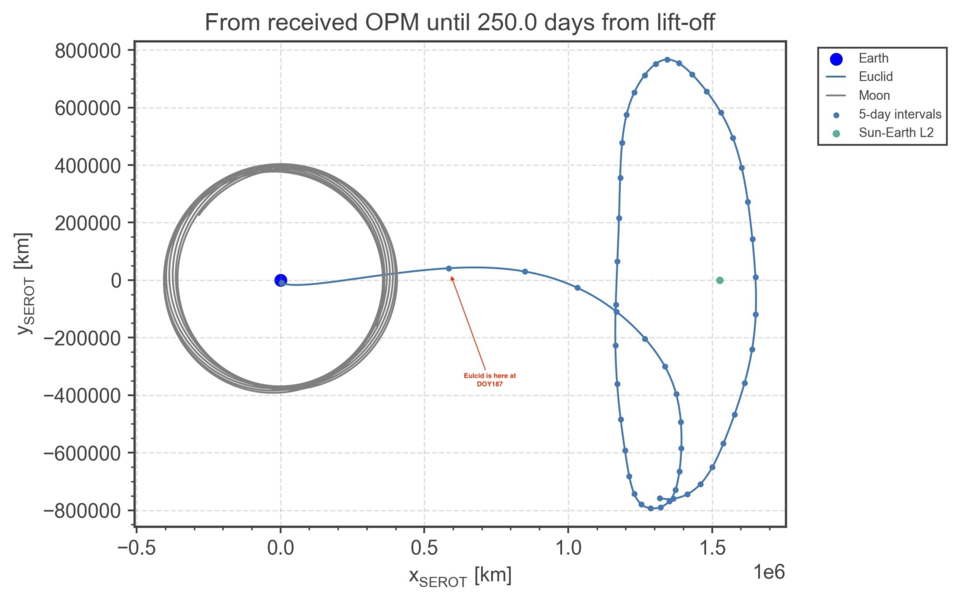
The journey towards L2 continues. This figure shows the position of Euclid on 6 July. The diagram traces the trajectory of the spacecraft as seen from above the Ecliptic plane, that is the Earth-Sun plane.
4–8 July. De-icing for perfect vision
Euclid needed to remove any moisture that could freeze on its telescope mirrors, obscuring and distorting its otherwise pristine views of the distant cosmos. To do this, Euclid was tilted towards the Sun. As sunlight entered the telescope tube and the temperature rose, any residual trace of ice evaporated away. This orientation was maintained for several days, to allow enough time for the water vapour to escape into space.
3 July. Execution of critical orbit manoeuvre
Launch and Early Operations Phase (LEOP) operations progressed nominally during the second day after launch. The main events were the execution of the first time-critical orbit control manoeuvre, reaction wheel tests and completion of remaining LEOP activities before the transition to commissioning operations.
2 July. On the way to L2
Commands have been sent to Euclid to execute a manoeuvre that successfully altered the spacecraft's trajectory by about 2.14 m/s and put it on course to join Gaia and Webb around Sun-Earth Lagrange point 2.


